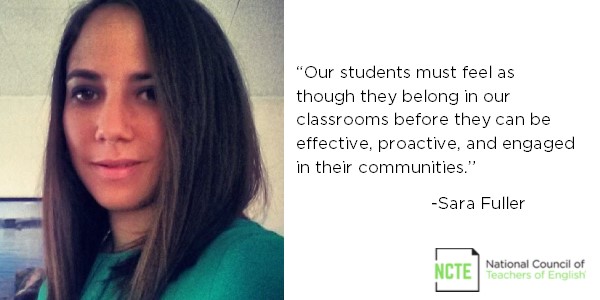The following post is by member Sara Fuller, assistant professor of English at Cuyahoga Community College and former middle and high school English teacher. This is part of an ongoing monthly series from the NCTE Standing Committee on Global Citizenship.
“We can never get a re-creation of community and heal our society without giving our citizens a sense of belonging.” Patch Adams, Do One Thing
For many of us, August brings the start of a new year with new students. Regardless of which age group we work with, this provides us with an opportunity to revisit ideas of citizenship and community.
The above quote from Patch Adams rings true for this time of year. Our students must feel as though they belong in our classrooms before they can be effective, proactive, and engaged in their communities.
The question then becomes, how do we create a sense of community within our classrooms? How do we make each and every student feel as though he or she belongs?
Here are some strategies you can try out in your classroom:
Compliments
Paige, from the Our Elementary Lives blog, suggests using “Compliment Circles” every few weeks in early elementary school. She writes that “[Compliment Circles] teach my students how to give and receive compliments as well as create a classroom of respect and kindness.” Read more here.
Jennifer Gonzalez of Cult of Pedagogy highlights another teacher, Stephanie, and her great idea for using compliments with older students. She points out that this may be more effective after students have gotten to know one another, but I think it’s worth adding to your repertoire of ideas! Read more about it here.
Classroom Contracts
Sarah, from More Than a Worksheet, suggests brainstorming good character traits for classmates to have. After brainstorming with students, create a list and post it for students. Read more about what she does here, and see an example!
I’ve done class contracts before. I like having students come up with their own expectations for respect and participating. In my experience, giving students ownership—regardless of their age—yields stronger results.
Growth Mindset
This is, of course, the buzzword of the moment, but it’s worth mentioning. As an educator at an open access school, I see students who have been told their whole lives that college isn’t for them. That school isn’t for them. That they can’t do it. And often they receive both overt and subtle messages saying, “You don’t belong here.”
It saddens me to think there are students who feel they don’t belong. And because they don’t think they belong, they don’t end up engaging with the other opportunities that school and life have to offer. They lose out on an important part of being a citizen of the world.
Britt, The SuperHERO Teacher, writes,
At the secondary level, it’s important for our students to understand the reasoning behind why we are learning about mindset in the first place. If you can convince your students that the knowledge they are about to learn is worthy of their time, they will be more apt to focus and take the lessons seriously. Providing students with the science behind growth mindset is a great starting point, but I think even more important is providing students with various examples of how growth mindset applies to their lives. Start with the connection between the brain and mindset, and then give specific scenarios to encourage students to continue learning.
Her point holds true for students from middle school through college. Let them know why it’s important, and give concrete examples to help increase buy-in. Britt has a lot more to say on the subject, which you can read here.
Laying the foundation of community and belonging will allow you to work with your students on becoming more active and engaged citizens throughout the rest of the school year. How do you build community in your classroom?
Happy teaching!

